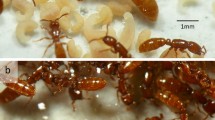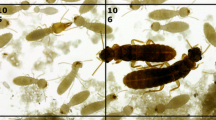Summary
During observations in the field, founding queens ofStrumigenys rufobrunea, Serrastruma serrula andSmithistruma emarginata were seen capturing prey and then bringing them back to the nest. These species have an archaic way of colony founding which we studied in the laboratory. It was relatively easy to eraise 10 workers in developing societies ofSerrastruma serrula in 7 months time: other species had slightly fewer workers during the same time. Our particular study was that of prey capture. The queens can locate the prey at a larger distance than the workers. The sequence of capture studied in four situations (small prey, typical prey — active or inert, large prey) are identical to those of the workers. With the exception of the capture of largey prey by the queens of genera with short mandibles (Serrastruma, Smitthistruma), the success rate of capture by the queen is not significantly better than that of the hunting workers in adult societies.
Resume
Des observations effectées dans la nature ont permis de voir des reines fondatrices deStrumigrenys rufobrunea. Serrastruma serrula etSmithistruma emarginata capturer des proies et les ramener au nid. Il y a donc chez ces espèces une fondation archaïque quenous avons étudiée au la boratoire. Le développement des jeunes sociétés en 7 mois permet d'atteindre facilement le stade de 10 ouvriéres chezSerrastruma serrula, un peu moins chez les autres espéces. La capture des proies est particulièrement étudiée. Les reines localisent les proies à une distance supérieure à celle des ouvrières. Les séquences de captures étudiées dans 4 situation (petite proie, proie “Typique” — active au inerte. grosse proie) sont identiques à celles des ouvrières. A l'exception de la capture desgrosdses proies par les reines des genres à mandibules courtes (Serrastruma, Smithistruma), le taux de réussite de capture par les reines n'est pas significativement meilleur que celui des ovrières chasseresses des sociétés adultes.
Similar content being viewed by others
References
Bovet P., 1983. — Analyse et modèle de trajets exploratoires de fourmis.Bull. Int. SFECA., 2, 33–39.
Brown W.L. Jr., 1953a. — Revisionary studies in the ant tribe Dacetini.Am. Midl. Naturalist, 50, 1–137.
Brown W.L., Jr., 1953b. — A preliminary report on Dacetine ants in Australia.Ann. Entomol. Soc. Am., 46, 465–471.
Clark J., 1925. — The ants of Victoria.Victoria Naturalist, 42, 58–64 135–144.
Cordero A.O., 1963. — An unusual behaviour of the leafcutting ant queenAcromyrmex oestospinosa (Reich).Rev. Biol. Trop., 11, 221–222.
Dejean A., 1980. — Le comportement de prédation deSerrastruma serrula (Santschi) (Formicidae-Myrmicinae). I. Capacité de détection des ouvrières, analyse des phases comportementales.Ann. Sc. Nat. Zool., 2, 131–143.
Dejean A., 1983. — La recherche des projes et le retour au nid chezSerrastruma lujae Formicidae. Myrmicinae, tribu des Dacetini).Bull. Int., SFECA, 2, 21–32.
Dejean A., 1985. — Etude éco-éthologique de la prédation chez les fourmis dui genreSmithistruma (Formicidae: Myrmicinae, Dacetini). III. La capture des proies chezS. emarginata.Ins. Soc., 32, 241–256.
Dejean A., 1986. — Etude du comportement de prédation dans le genreStrumigenys (Formicidae: Myrmicinae).Ins. Soc., 33, 388–405.
Dumpert K., 1981. —The social biology of ants. Pitman Publishing, 297 p.
Hardmann J.M., Turnbull A.L., 1980. — Functional response of the wolf spiderPardosa vancouveri to changes in the density of vestigialwinged fruit flies.Res. Popul. Ecol., 21, 233–259.
Haskins C.P., Einzmann E.V., 1938. — Types of colony-initiation in the Ponerinae and degenereation of wing musculature in the queen.Ann. N. Y. Acad. Sci., 47–162.
Haskins C.P., Haskins E.F., 1950. — Notes on biology and sociakl behaviour of the archaic Ponerine ants of the generaMyrmecia andPromyrmecia.Ann. Entomol. Soc. Am., 43, 461–494.
Höllodobler K., 1938. —Zool. Anz., 121, 66–72. In Dumper, 1981.
Holling C.S., 1966. — The functional response of invertebrate predators to prey density.Mem. Entomol. Soc. Can., 48, 1–86.
Le Masne G., Bonavita A., 1969. — La fondation des sociétés selon le typeMyrmecia chez la fourmiManica rubida. VI. Congress IUSSI, Bern. 137–147.
Levin N.A., 1980. — Variability of olfactory behaviour ofCimex lectularius L. depending on feeding regime.Zh. Obshch. Biol. 41, 940–943.
Weber N.A., 1940. — The biology of the fungus-growing ants. Pt. VI: Key toCyphomyrmex, new Attini and a new guest ant.Rev. Entomol., Rio de Janeiro, 11, 406–427.
Wesson L.G., Wesson R.G., 1939. — Notes onStrumigenys from southern Ohio, with description of six new species.Psyche, 46, 91–112.
Wheeler W.M., 1933. — Colony founding among ants, with an account jof some primitive Australian species.Harvard Univ. Press. Publ., Cambridge Mass., 179 p.
Wilson E.O., 1954. — The ecology of some north American Dacetine ants.Ann. Entomol. Soc. Am., 46, 479–495.
Wilson E.O., 1971. —The Insect Societies. The Belknap Press of Harvard, University Press, Cambridge, Mass., 548 p.
Author information
Authors and Affiliations
Rights and permissions
About this article
Cite this article
Dejean, A. New cases of archaic foundatioin of societies in Myrmicinae (Formicidae): Study of prey capture by queens of Dacetini. Ins. Soc 34, 211–221 (1987). https://doi.org/10.1007/BF02224086
Received:
Accepted:
Issue Date:
DOI: https://doi.org/10.1007/BF02224086




